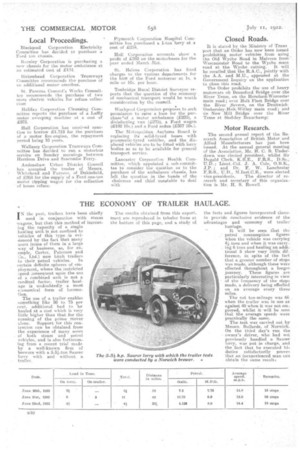THE ECONOMY OF TRAILER HAULAGE.
Page 8

If you've noticed an error in this article please click here to report it so we can fix it.
IN the past., trailers have been chiefly
used in conjunction with Steam wagons, but that. this method of inpreasing the capacity of a single hauling unit is not confined to vehicles of this type is evidenced by the fact that many users (some of them in a large way of business, as, for example, Carter, Paterson and Co., Ltd.) now hitch trailers
to their petrol vehicles. In certain definite, spheres of employment, where the restricted s;peed consequent upon the use of a combined unit is not a cardinal factor, trailer haulage is undoubtedly a most damoinicat form of locomo• tion.
The use of a trailer enables somethinglike 50 to 75 per cent, additional had to be hauled at a cost which is very little higher than that for the running of the prime Inlayer
;Ione. Support for this contention can be obtained from the experience of many users of ball steam and petrol vehicles, and is also forthcoming from a recent. trial made by a well-knowe firm of brewers with a 5-5-ton Saurer lorry with and without a trailer.
ca.n
The results oh ed from this experi_ ment are reproduced in tabular form at the bottom of this page, and a study of. the facts and figures incorporated therein provide conclusive evidence of the advantages and .economy of trailer haulage. It will be seen that the petrol consumption figures when the vehicle was carrying 4L. tons and when it was carrying 6 tons and hauling an additional 5 show very little. difference, in spite of the factthat a greater number of steps was made, although these were effected throughout a longer. journey. These figures are particularly interesting in view of the frequency of the stpp3 made, a delivery being effected on an average every three
The net ton-mileage was 66 when the trailer was in use as against 40 when it was not employed, whilst it will be seen that the average speeds were practically the same,
The test was carried out. by Messrs. Bullard's, of Norwich. On the third day's run the owner's driver, who had not previously handled a Saucer lorry, was put in charge, and the fact that he executed his duties satisfactorily proves that an inexperienced man can obtain the same results






























